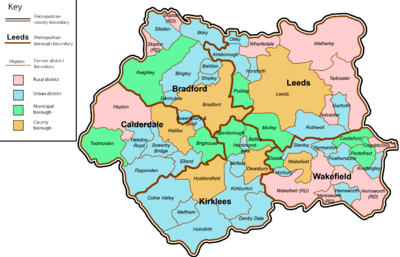List of mills in Bradford facts for kids
This article is about the many textile mills in Bradford, a large town in West Yorkshire, England. Textile mills are factories where raw materials like wool or cotton are turned into fabric. Bradford became very famous for its wool mills, especially during the Industrial Revolution. These mills were super important for the town's growth and history.
Contents
What are Textile Mills?
Textile mills are like big workshops where people make cloth. Imagine taking fluffy wool from sheep or soft cotton plants and turning them into the clothes you wear! That's what happened in these mills. They used machines to spin the wool into yarn and then weave the yarn into fabric.
Bradford's Textile Story
Bradford was once known as the "wool capital of the world." This was because it had so many mills that processed wool. The town grew very quickly because of these mills, and many people moved there to work. The mills were not just places of work; they shaped the whole city, from its buildings to its culture.
Some Important Mills in Bradford
Bradford had hundreds of mills, each playing a part in making the town famous for textiles. Here are a few examples from different areas of Bradford:
Allerton Mills
- Allerton Mill: One of the many mills in the Allerton area.
- Fairweather Green Mills: Another important mill complex.
- Top Mill: A mill located in the higher parts of Allerton.
Bolton Mills
- Bolton Woods Mill: A mill found near the woods in Bolton.
- Oswin Mills: Another mill that helped make textiles in this area.
Bowling Mills
The Bowling area had many mills, showing how busy it was with textile work.
| Name | Architect | Location | Built | Demolished | Served (Years) |
|---|---|---|---|---|---|
| Bowling Mills | Bowling (Bradford), SE 1658 3197 53°47′02″N 1°44′59″W / 53.78378°N 1.74985°W | ||||
| [[|frameless|upright=0.8]] | Notes: National Building Register:62534: (B) | ||||
- Albion Mill: A mill named after an old poetic name for Britain.
- Central Mills: Located in a central part of Bowling.
- Globe Mills: Another mill with a well-known name.
- Victoria Mills: Named after Queen Victoria, showing its age.
Bradford City Centre Mills
The main part of Bradford also had many important textile buildings.
- Barkerend Mills: A large mill complex that was very active.
- Conditioning House: This wasn't a mill, but a place where wool was tested to make sure it was good quality before being sold.
- The Wool Exchange: A famous building where wool merchants would meet to trade. It was like the stock market for wool!
- Midland Mills: Another significant mill in the city.
Heaton Mills
- Frizinghall Works: A large factory in the Frizinghall area.
- Springfield Mills: A mill known for its location near a spring.
Horton Mills
Horton was another busy area for textile production.
- Albert Mills: Named after Prince Albert, Queen Victoria's husband.
- Cannon Mills: A very important mill in Horton.
- Legrams Mill: A large and well-known mill.
- St Andrew's Mills: Named after a saint, showing the history of the area.
Manningham Mills
Manningham was home to some of the biggest and most famous mills.
| Name | Architect | Location | Built | Demolished | Served (Years) |
|---|---|---|---|---|---|
| Lumb Lane Mills Drummond's Mill |
Lockwood & Mawson | Manningham (Bradford), SE 1565 3385 53°48′03″N 1°45′50″W / 53.80070°N 1.76387°W | 1885 | 2016 | 117 |
| [[|frameless|upright=0.8]] | Notes: National Building Register:62477: (B) | ||||
| Manningham Mills | Manningham (Bradford), SE 1450 3490 53°48′37″N 1°46′53″W / 53.81017°N 1.78128°W | ||||
| Notes: National Building Register:62439*: (A) | |||||
- Manningham Mills: This was one of the largest and most impressive silk and velvet mills in the world! It had beautiful architecture and was a huge employer.
- Whetley Mills: Another important mill in Manningham.
- Try Mills: A significant mill that contributed to the area's textile output.
These mills were the heart of Bradford for many years, providing jobs and making the city a global leader in textiles.
See also
- Heavy Woollen District
- Textile processing


